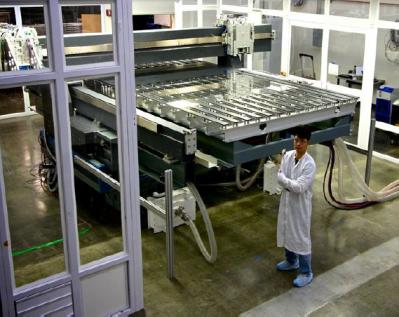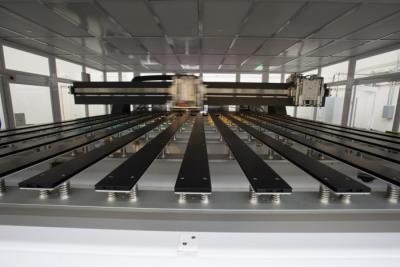Kateeva unveiled a new mass production flexible OLED thin film encapsulation (TFE) system based on their ink-jet technology. The YIELDjet FLEX can enable cost-effective encapsulation deposition, and Kateeva says that the first mass-production system will ship to a customer in Asia later this month. This customer is probably Samsung Display (which recently invested in Kateeva), but this is not confirmed.

Kateeva says that inkjet printing enables superb particle performance, high efficiency and excellent scalability. The YIELDjet system is enclosed in a pure-nitrogen chamber, which is the best OLED processing environment, shielding the OLED materials from moisture and air. The ink-jet system provides exceptional planarization of substrate surface structures and particles and results in unprecedented film uniformity.
Samsung is currently using Vitex's multilayer thin-film encapsulation (TFE) using three layers (this is a new achievement, up until now they had to use at least 6 layers). While Samsung will still use this technology for its current displays, they are also considering other encapsulation deposition technologies (such as Veeco's FAST-ALD and Universal Display's UniversalBarrier). But if SDC is indeed Kateeva's customer, this is their first mass-production next-gen encapsulation technology.
 After years in stealth-mode, one year ago Kateeva finally unveiled their YIELDjet ink-jet printing systems. Following the announcement, we discussed Kateeva's technology and business with Dr. Conor Madigan, the company's President and Co-founder. Conor was kind enough to answer a few question we had regarding the new encapsulation system.
After years in stealth-mode, one year ago Kateeva finally unveiled their YIELDjet ink-jet printing systems. Following the announcement, we discussed Kateeva's technology and business with Dr. Conor Madigan, the company's President and Co-founder. Conor was kind enough to answer a few question we had regarding the new encapsulation system.
Q: Conor, Can you tell us why an inkjet printer is a good encapsulation tool? After all this is an area-type deposition (expect the display edges)
With the proper algorithms, inkjet printing can achieve exceptional large-area uniformity. To avoid optical mura, superb uniformity is essential for the organic interlayer between the inorganic barrier layers. Since this is a top-emission device and the display is viewed through the barrier layers, other wet coating techniques struggle to achieve the necessary uniformity.
In addition, the display edge is critical. Customers have very tight tolerance for the display edge as this controls the bezel width and there is constant pressure to reduce the bezel region. Inkjet is the only technique with sufficient accuracy that offers the capability to coat and pattern in a single step. This makes it by far the most cost-effective method for mass production.
Interestingly, we discovered that the combination of fine-edge accuracy and high-coating uniformity make this a very high-precision inkjet application, even though the coating area is a macro-scale feature.
Q: Another leading technology for encapsulation deposition is ALD. How do you see the competition between these two technologies?
Actually, ALD and inkjet are complementary, not competitive. Techniques like ALD, CVD and sputtering deposit inorganic barrier layers. However, the organic interlayer is essential to realizing high yield in mass production for the encapsulation coating that is formed over the OLED display.
But the inorganic layer alone can’t planarize the display’s substantial surface topology and the many particles on the display near the end of the manufacturing process. Without such planarization, the inorganic films develop stress points around the surface structures that lead to failures during bending. This is something that was only recently identified as a key enabler of high-yield TFE.
In addition, the inorganic coating over the display requires patterning. Currently, this involves shadowmasks, which are notorious particle generators. This means that even the inorganic coating step itself is not perfectly clean, leading to further defect issues if organic interlayers are not utilized.
It is important to note that the blanket coating of the substrate before the backplane manufacturing begins, is a much simpler step. There is no topology and no patterning, and the substrate can be prepared to be relatively particle free. For this step there are many more options, and inkjet organic interlayers are not necessarily required.
Q: What kind of materials can be deposited using your inkjet printers?
We don’t disclose specific chemistries of the materials that we deposit, but we can discuss the characteristics for TFE. The films are liquid precursor inks that are solidified by way of a curing step after printing. To accommodate the OLED device, the curing step is performed at temperatures below 80 C. The solid films are highly transparent and flexible, and have no measureable outgassing at temperatures of up to 150 C.
Kateeva is producing its own encapsulation materials, but your system can also be used to deposit materials from other companies. What is your business model exactly? Can you detail your material performance as well? And maybe some collaboration you've done with other material providers?
Our business is to provide manufacturing equipment. That said, we believe it’s essential to also offer a high-quality reference process. This calls for high-quality inks. Some customers already have excellent inkjet inks, in which case we provide equipment for use with their inks. When necessary, we can also help develop the reference processes with the customer. For customers that don’t have their own inks, we provide reference inks and processes so they can get started immediately.
We’re committed to making every customer successful. If they prefer, customers can start with our inks and switch later to other inks, or continue using our inks in production. There are no restrictions.

Q: How soon before we can expect a flexible OLED panel on the market with ink-jet printed encapsulation?
You should see products next year.
Q: Is Kateeva currently focused solely on encapsulation? Or do you also market your inkjet systems for other material depositions?
The beauty of the YIELDjet platform is its incredible versatility. Consider it a general platform for precision deposition of many different materials. So, while the YIELDjet FLEX is focused on TFE, you will soon see Kateeva products for other materials. For example, our work on soluble RGB OLED device printing for displays is proceeding very well, with notable achievements in critical areas like T95 lifetime. Expect to see a Kateeva product for that application in the near term.
Beyond that, we are eyeing other applications in OLED lighting and even printed solar cells. The concept of a high-performance printing system for precision deposition has captured worldwide attention. Obviously, we need to be smart about where we dedicate resources, so, as you might expect, our product strategy is practical and extremely focused.
Q: At this stage, soluble OLED materials (emitters, etc.) are not as efficient and long-lasting as evaporable materials. Will inkjet be used for low-cost OLEDs or do you see soluble OLEDs matching evaporable ones?
The performance of inkjet-printed OLEDs is increasing at an amazing rate. In fact, one of our most exciting breakthroughs this year has been to demonstrate higher T95 performance via N2 processing. With lifetimes increasing rapidly and approaching the levels of vacuum-deposited devices, we are finding that the processing environment is more critical than ever. In the past, when inkjet device performance was so poor, contamination from air processing was the least of the problems. Now, material purity and intrinsic material quality is so good that high-purity processing environments are essential.
We have discussed specifications for TV mass production with several customers. We expect to meet the requirements for TV device performance by the end of next year through steady co-work with our soluble material supplier partners.
Q: When do you see inkjet-printed displays or TVs on the market?
We believe the first mass-production lines could be installed in 2016, so 2017 is a real possibility.
Q: Kateeva recently raised $38 million from Samsung and others. Well done. Can you tell us what will the money be used for?
We intend to scale up our customer satisfaction and manufacturing organizations. We’re about to install the first of our YIELDjet systems in mass production. From here, we aim to provide industry-leading support and product quality assurance. Funds will also be applied to technology and product development, primarily for development of next-generation TFE systems and our RGB systems.
Dr. Madigan, thanks again for your time and information. I wish you and the whole Kateeva team the best of luck!

